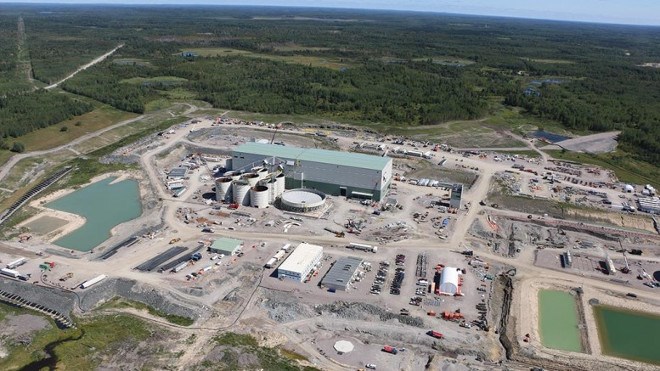After suffering through five lean years, optimism is slowly returning to the mineral exploration sector, and nowhere is that more evident than in northwestern Ontario.
Fresh from soaking in the buoyant atmosphere at the Prospectors and Developers mining convention in Toronto in March, John Mason sees more geologists in the field, once-dormant drilling companies have rigs turning, and shortages of skilled and experienced labour are being reported in some areas.
“The optimism is real in terms of the money starting to flow,” said the project manager of mining services for the Thunder Bay Community Economic Development Commission, as prices for gold and other metals begin to rebound and exploration capital is more readily available.
When the City of Thunder Bay released its Mining Readiness Strategy in 2013, it pinpointed nine projects in the region that had near-term potential to become mines.
A few more have since entered the picture, including Harte Gold’s decision to transition its Sugar Zone project, north of White River, into commercial production in 2018.
Action in the Hemlo gold camp along Lake Superior’s North Shore is heating up with reports that Barrick will realize 10 more years of life out of its Williams Mine after the mining company performed 18 months of exploration.
It’s encouraged several junior companies to take a second look at the small greenstone belt. Those outfits with ground staked near, or adjacent to, Barrick can more easily raise money for exploration.
“That may lead to more discoveries, and may result in one or two more deposits being found,” said Mason.
Exploration had taken place there in fits and starts when gold prices spiked in the 1980s and the first decade of the 2000s, “but it’s still very limited. It needs another fresh look.”
Mason said one of the better projects is Pure Gold’s Madsen project, southwest of Red Lake. From the mid-1930s to the mid-1960s, the Madsen Mine was a significant producer with 2.5 million ounces. More exploration work still needs to be done, but Mason believes there’s a great opportunity for that mine to return to production one day.
One commodity that came out of left field was lithium.
“The price has gone quite crazy in the last 18 months because of lithium-ion battery requirements,” said Mason, of the silver-metal metal that’s powering the electric vehicle and smartphone markets.
Two of the better projects in terms of grade and resource are Avalon Advanced Minerals’ Separation Rapids project, north of Kenora, and Frontier Lithium’s PAK project, north of Red Lake.
Another green metal is graphite, the focus of Zenyatta Ventures’ rich Albany deposit, near Hearst.
The company has collaborated with an Israeli company and Ben Gurion University to develop concrete mixtures containing graphene. They’re also working with interests in Japan and other countries on the fuel cell and lithium battery sphere.
Among the goals of the mining readiness plan was to promote Thunder Bay as a service and supply hub, but also as a bedroom community that the mining workforce can call home.
Cliffs Natural Resources abandoned its Thunder Bay office in 2013 when it called off its expensive foray into the Ring of Fire, but Goldcorp has settled into expanded Inner City space to handle the administration for its remote Musselwhite Mine, 480 kilometres to the north.
Management is seeking to boost annual production from the 200,000-230,000-ounce range to 300,000 ounces through an aggressive exploration on its large claim holdings. North Bay mining contractors, Redpath, are involved in a $90-million materials handling project to efficiently haul ore to the surface from 1,000 metres under Lake Opapimiskan.
Instead of flying personnel from across Canada into the mine site on a rotational basis, the company wants to ensconce more employees in Thunder Bay, and establish a greater presence in the community through a number of philanthropic endeavours. Close to 30 per cent of the mine’s workforce already lives in the city.
“Part of the message is not just hiring but retaining workers, and keeping them happy,” said Mason.
The stalled Ring of Fire mineral belt in the James Bay region isn’t totally off Thunder Bay’s radar. Mason is engaged in talks with the nearby Fort William First Nation on how to best utilize and promote the expansive Grand Trunk railway lands on the reserve as a heavy industrial park for mineral processing, possibly as a ferrochrome smelter for Noront Resources.
Mason said the best evidence of how mining has reshaped Thunder Bay’s economy is the business spinoffs from New Gold’s Rainy River open-pit project, now under construction northwest of Fort Frances.
As of March, 31 Thunder Bay companies had participated on the supply and service side, handling engineering, fabrication, environmental and health and safety needs for the mine-mill complex. An estimated $80 million has flowed back to these companies, and the project has gobbled up every available unionized millwright, welder and pipefitter in the northwest.
“Well over 1,000 people are on-site,” said Mason. “Four hundred on the operational side, as they train and get ready for the finish line at the end of November for production, and more than 600 contractors who are finishing off the mill. It’s a massive undertaking.”
Mason often meets with the mining companies’ business development managers and procurement officers to ensure local companies are prepared to bid on contracts.
“Whether it’s in maintenance or repair, you need a cadre of key companies that can be called in, formally through an RFP process (or) if you have a major breakdown or schedule shutdown.
“They’re not going to bring somebody in from Alberta or Newfoundland. If you’ve got the talent here, that’s a few hours away, why would you not use them?”
Mason finds the city’s suppliers and service companies themselves are more keenly aware of the exploration projects in the region and more educated on development sequence and the miners’ anticipated service needs.
“Some of these companies get it and have transformed their companies to be right on the mark; others still need help.”




